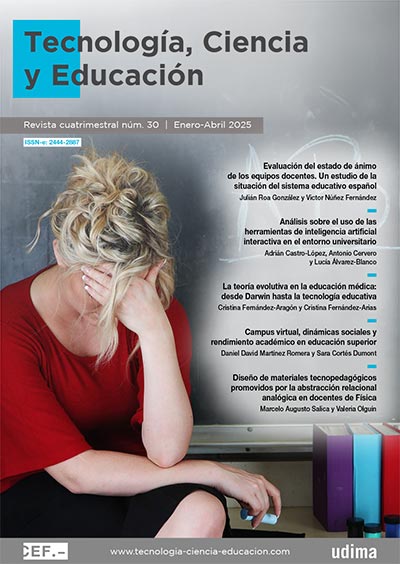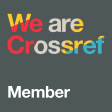Cerrando la brecha educativa para estudiantes de primera generación: un estudio exploratorio sobre aprendizaje interactivo para menores de bajos recursos en la India
DOI:
https://doi.org/10.51302/tce.2025.19449Palabras clave:
enseñanza y aprendizaje interactivo, aprendizaje interactivo en la escuela primaria, estudiantes de primera generación, India, clases desfavorecidas, equidad, tecnología interactiva para el aprendizajeResumen
Algunas investigaciones en el campo de la educación asistida por ordenador señalan que herramientas interactivas, donde la información se presenta a través de recursos digitales, tales como texto, imágenes fijas, gráficos, animaciones, vídeo, audio, etc., aumentan el rendimiento de los estudiantes (hombres y mujeres), ya que estos prestan más atención y disfrutan más de las lecciones impartidas con herramientas interactivas. En la India, un número creciente de estudiantes pertenecientes a clases desfavorecidas abandonan las escuelas debido a una serie de factores que contribuyen a ello, como la incapacidad para costear la educación, la falta de interés de los padres, el acceso al transporte, etc. El presente estudio explora el potencial de un prototipo de aprendizaje interactivo de un sitio web para aumentar el compromiso, la retención y el nivel de aprendizaje de estudiantes de cuarto grado, que son, a su vez, estudiantes de primera generación. El estudio emplea una metodología mixta en la que se utilizaron la observación en clase, las entrevistas semiestructuradas, pruebas y un cuestionario como instrumentos para recopilar datos cualitativos y cuantitativos de 58 participantes. Se examinaron dos tipos de grupos, experimental y de control, en las asignaturas de Ciencias Ambientales y Matemáticas. A los grupos experimentales se les enseñó a través del sitio web y a los grupos de control a través de una clase tradicional. Los resultados indican que las puntuaciones promedio de las pruebas de los grupos experimentales en ambas materias fueron más altas que las de los grupos de control. Los estudiantes prefirieron aprender a través de herramientas interactivas con imágenes coloridas y animaciones.
Descargas
Citas
ASER Centre. (2021). Annual Status of Education Report (Rural) 2021. http://asercentre.org/Keywords/p/394.html
Argüelles Cruz, A. J, Cortés Díaz, H. D. and Piñal Ramírez, O. E. (2023). Ramath: mathematics teaching app. Tecnología, Ciencia y Educación, 25, 93-110. https://doi.org/10.51302/tce.2023.2800
Bourn, D. and Soysal, N. (2021). Transformative learning and pedagogical approaches in education for sustainable development: are initial teacher education programmes in England and Turkey ready for creating agents of change for sustainability? Sustainability, 13(16), 1-19. https://doi.org/10.3390/su13168973
Çetin, H. S. (2018). Implementation of the digital assessment tool «Kahoot!» in elementary school. International Technology and Education Journal, 2(1), 9-20.
Chaturvedi, B. K. (2020). Six million children out of school in India due to the impact of COVID-19; girls most affected. National Herald. https://www.nationalheraldindia.com/india/six-million-children-out-of-school-in-india-due-to-the-impact-of-covid-19-girls-most-affected
Cogill, J. (2003). The use of interactive whiteboards in the primary school: effects on pedagogy. ICT Research Bursaries, 52.
Cross, A., Ashok, B., Bala, S., Cutrell, E., Datha, N., Kumar, R., Kumar, V., Parthasarathy, M., Prakash, S., Rajamani, S., Sangameswaran, S., Sharma, D. and Thies, W. (2014). Online learning versus blended learning: an exploratory study. Proceedings of the first ACM conference on Learning@ scale conference (pp. 179-180). https://doi.org/10.1145/2556325.2567869
Dey, P. and Bandyopadhyay, S. (2019). Blended learning to improve quality of primary education among underprivileged school children in India. Education and Information Technologies, 24(3), 1.995-2.016. https://doi.org/10.1007/s10639-018-9832-1
Guamán-Guaya, B. and Cid-Górriz, R. (2024). Project work from a virtual learning platform: satisfaction experiences of a group of primary school students. Tecnología, Ciencia y Educación, 27, 143-166. https://doi.org/10.51302/tce.2024.18641
Guo, X. and Wu, M. (2018, May). An empirical study of rural primary school students' English knowledge construction based on interactive mobile learning application. Proceedings of the 2018 International Conference on Distance Education and Learning (pp. 6-10). https://doi.org/10.1145/3231848.3231852
Hilliard, A. and Kargbo, H. F. (2017). Educationally game-based learning encourages learners to be actively engaged in their own learning. International Journal of Education and Practice, 5(4), 4560. https://doi.org/10.18488/journal.61.2017.54.45.60
Kennewell, S. and Morgan, A. (2003, July). Student teachers' experiences and attitudes towards using interactive whiteboards in the teaching and learning of young children. Proceedings of the international federation for Information Processing Working Group 3.5 Open Conference on Young Children and Learning Technologies (Vol. 34, pp. 65-69).
Kundu, A. (2018). Blended learning in Indian elementary education: problems and prospects. Journal of Online Learning Research, 4(2), 199-227.
Ministry of Statistics & Programme Implementation. (2019). Key Indicators of Household Social Consumption on Education in India NSS 75th Round (July 2017-June 2018). Press Information Bureau, Government of India. https://www.pib.gov.in/Pressreleaseshare.aspx?PRID = 1593251
Nusir, S., Alsmadi, I., Al-Kabi, M. N. and Sharadgah, F. (2012). Studying the impact of using multimedia interactive programs at children ability to learn basic math skills. Acta Didactica Napocensia, 5(2), 17-32.
Rachmadtullah, R. M. S. Z., Ms, Z. and Sumantri, M. S. (2018). Development of computer-based interactive multimedia: study on learning in elementary education. International Journal of Engineering & Technology, 7(4), 2.035-2.038.
Ramya, M. (2012). Rote learning an evil in education system, national survey reveals. The Times of India. https://timesofindia.indiatimes.com/home/education/news/Rote-learning-an-evil-ineducation-system-national-survey-reveals/articleshow/17564012.cms
Roschelle, J. M., Pea, R. D., Hoadley, C. M., Gordin, D. N. and Means, B. M. (2000). Changing how and what children learn in school with computer-based technologies. The Future of Children, 10(2), 76-101.
Schmitz, B., Czauderna, A., Klemke, R. and Specht, M. (2011). Game based learning for computer science education. Proceedings of the 2011 Computer Science Research Education Conference (pp. 81-86).
Shager, H. M., Schindler, H. S., Magnuson, K. A., Duncan, G. J., Yoshikawa, H. and Hart, C. M. (2013). Can research design explain variation in head start research results? A meta-analysis of cognitive and achievement outcomes. Educational Evaluation and Policy Analysis, 35(1), 76-95.
Sinha, S. (2011). Does Khan Academy really work? HuffPost. http://www.huffingtonpost.com/shantanu-sinha/does-khan-academy-really_b_946969.html
Stratton, S. J. (2021). Population research: convenience sampling strategies. Prehospital and Disaster Medicine, 36(4), 373-374. https://doi.org/10.1017/S1049023X21000649
Tembang, Y., Purwanty, R., Palobo, M. and Kabrahanubun, R. I. (2020). Development of interactive based powerpoint learning media in the class IV students of merauke basic school. Proceedings of the 4th International Conference on Learning Innovation and Quality Education (pp. 1-6).
Tobin, E. and Hieker, C. (2021). What the EdTech experience in refugee camps can teach us in times of school closure. Blended learning, modular and mobile programs are key to keeping disadvantaged learners in education. Challenges, 12(2), 19. https://doi.org/10.3390/challe12020019
Yip, F. W. and Kwan, A. C. (2006). Online vocabulary games as a tool for teaching and learning English vocabulary. Educational Media International, 43(3), 233-249. https://doi.org/10.1080/09523980600641445
Descargas
Publicado
Versiones
- 10-01-2025 (2)
- 09-12-2024 (1)
Cómo citar
Número
Sección
Licencia
Derechos de autor 2024 Swaralipi Roy Chowdhury Samanta, María Victoria Soulé

Esta obra está bajo una licencia internacional Creative Commons Atribución-NoComercial-SinDerivadas 4.0.

























